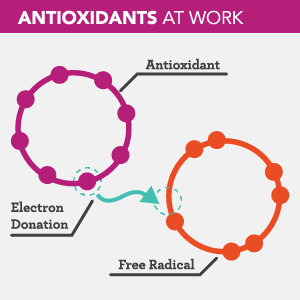When it comes to strengthening your immune system at the onset of flu season, there are a number of tried-and-true methods to give yourself a boost (read: green tea, Vitamin C supplements, etc). But how did these remedies gain such popularity? To answer this, let's turn to science.
Cold Season
 |
| Source |
Cold Season
Firstly, what is the common cold? While we don't know exactly what causes it, the "common cold" refers to a number of viruses that cause similar symptoms in the upper respiratory tract, like runny nose, sore throat, cough, etc. The most common of these is the Rhinovirus, which accounts for anywhere between 10% - 40% of of all "colds". And while colds are usually treated symptomatically (as we have no cure for viruses), studies have shown that by minimizing free radicals in the system, antioxidants can help the immune system fight viral infections more efficiently.
What are free radicals?
When atoms have unpaired electrons in their valence shell, they are free to pair with other unpaired electrons in different atoms, creating chemical bonds. However, exposure to oxygen (called oxidation) can cause these valence electrons to break away from the atom, creating "free radicals".
 |
| Source |
Free radicals are dangerous because they latch on to other atoms' unpaired electrons, causing cellular damage, including damage to the cell's DNA. And when one cell's structure has been changed by free radicals, it causes a molecular chain reaction, creating more free radicals in the process.
 |
| Source: Greatist |
However, this is where antioxidants come into play. Antioxidants stop the chain reaction in its tracks by "donating" electrons to the unpaired valence shells, making them more stable.
Now, a quick disclaimer: scientists still aren't sure of the exact role antioxidants play in our overall health. In addition, it is known that a certain amount of free radicals are required in the body to perform some necessary biological functions. And, like any sort of chemical in the body, there can always be too much of a good thing. Certain studies have shown that an overabundance of antioxidants in the body can lead to a number of health problems.
The point here is that it's all about finding balance. There are a number of ways we can support our natural production of antioxidants through dietary means, but this article isn't a license to go overdose on beta-carotene. Everything in moderation!
Sources of Antioxidants
The three main sources of antioxidants are:
Vitamin C: Also known as ascorbic acid, vitamin-c is water soluble, meaning an excess supply of this nutrient passes through the urinary tract when ingested in large amounts. Found in kale, strawberries, oranges, yellow bell peppers, and guavas.
Vitamin E: actually refers to a group of 10 lipid(or fat)-soluble compounds that protect the cell membrane from the oxidation process. Found in sunflower seeds, almonds, avocados, spinach, and asparagus.
Beta-Carotene: the pigment that makes carrots and pumpkins orange, beta carotene is the primary dietary source of Provitamin A (meaning it can be chemically converted into Vitamin A). Found in carrots (obviously), sweet potatoes, dark leafy vegetables (like spinach and kale), squash, and cantaloupe.
This chart from Greatist is an awesome reference for finding sources of the antioxidants listed above, as well as many others:
 |
| Source: Greatist |


No comments :
Post a Comment